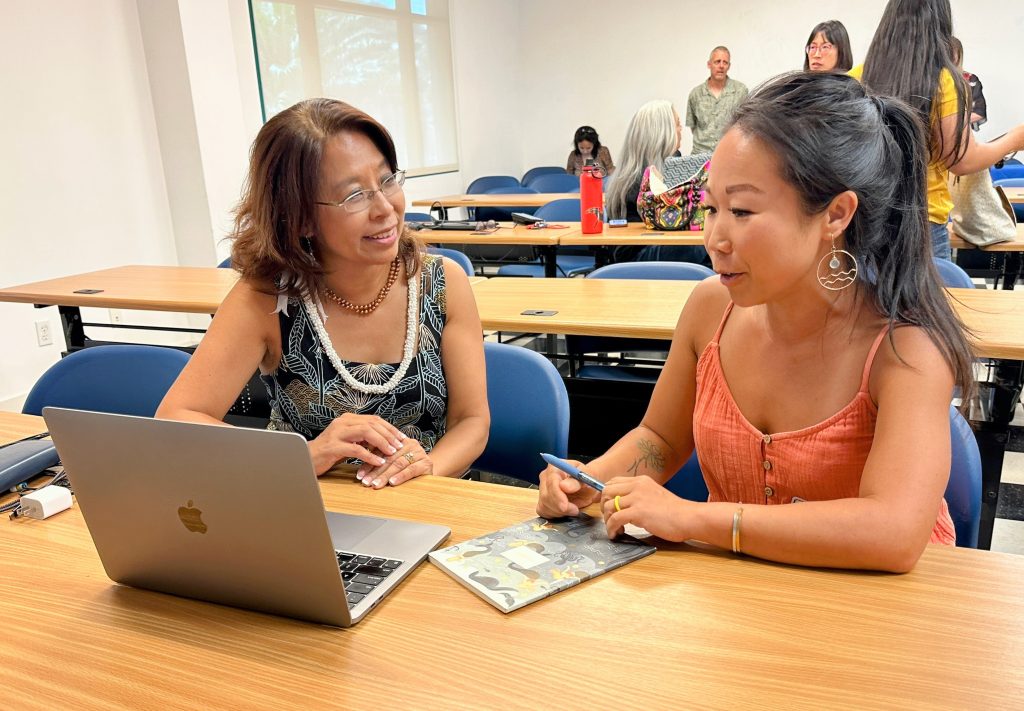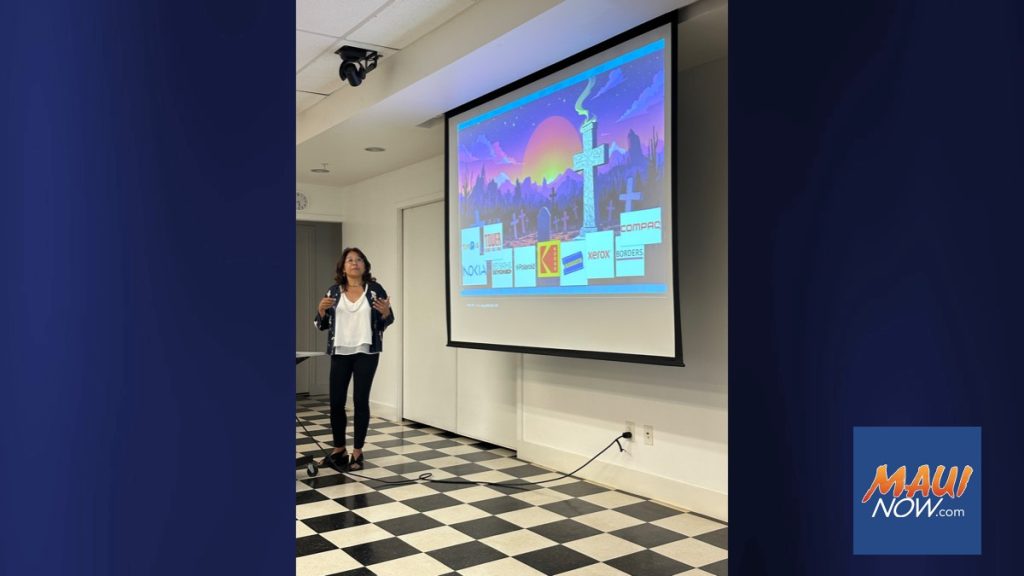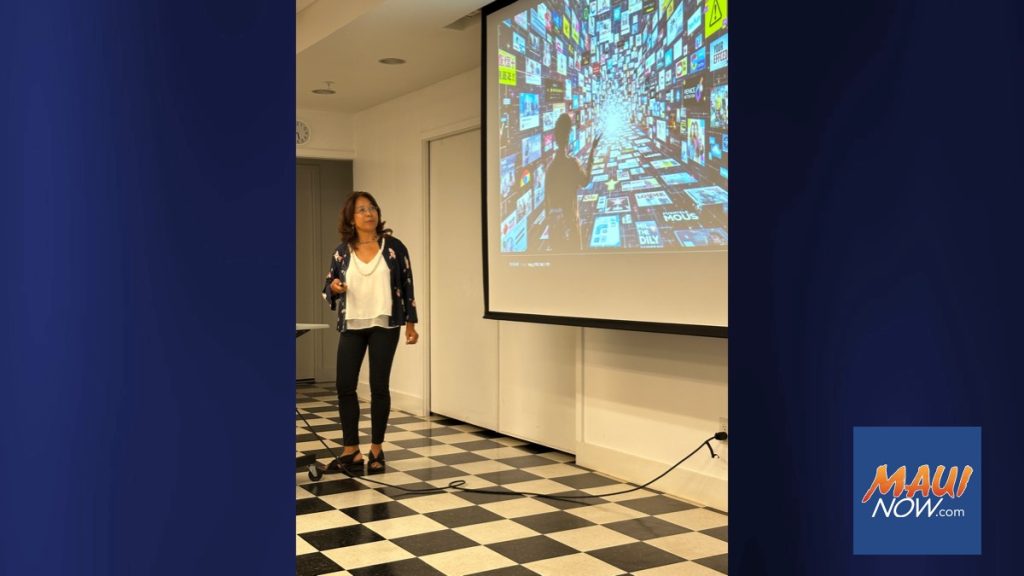
The next time you call customer service, the human voice you hear might not actually be human. It might be a machine; a computer programmed to cheerfully manage countless routine customer complaints and service calls, 24/7 without fatigue, overtime or grumbling.
“Conversational AI is a game changer,” said marketing expert and business strategist Jennifer Apy, a 1983 Baldwin High School graduate now living in the East Bay Area. “It can handle outreach tasks like appointment scheduling, and route inbound calls at scale, without having to navigate an annoying recorded menu.” In 90-minute Maui TechOhana presentations over two days last week at the Malcolm Center in Kīhei, Apy explained how artificial intelligence is revolutionizing business and life in general in ways many of us don’t even know.
Examples of what’s called Large Language Models or conversational AI include: Gemini, ChatGPT, Claude (by Anthropic), Microsoft Copilot, Perplexity AI, Meta AI and Grok (by xAI). Each occupies a niche in the AI cyberscape. Most offer free tiers of service with paid subscriptions for more features like higher usage limits and faster response times.
Apy, area managing partner with Chief Outsiders, the largest fractional executive firm for marketing and sales, has provided her marketing expertise to Fortune 500 companies such as Mattel, Adobe and Intuit.
She said AI is no longer a futuristic concept, like “Hal,” in the 1968 classic film “2001: Space Odyssey.” Now, artificial intelligence is transforming industries at a breathtaking pace.
Apy’s initial session focused on general marketing principles, and it laid a foundation for the next day’s talk on AI and how it’s reshaping business. This technology can empower Maui’s diverse economic landscape, from small businesses to broad established sectors like tourism and agriculture.
Just as “Hal” had a dark and sinister side in the fictional movie, AI raises fearsome questions about ethics, morality, biases and unforeseen negative outcomes, like replacing humans.
Addressing such concerns, Apy said that AI, at its core, is “using technology in order to be able to do something quicker, faster.” She encouraged attendees not to be intimidated by jargon, saying, “Don’t get thrown off by all these terms of things. It’s just like a lot of computers, a lot of computer automation.” She said that “all functions within an organization are adopting AI as we speak,” indicating its widespread applicability across various business sizes and sectors. “As humans we need to understand how we can use AI to make our work and lives better, in order to stay ahead of it.”
The second day’s session moved beyond definitions to showcase real-world applications for artificial intelligence.
For example, Apy detailed how AI is being used for “generative AI analysis,” helping businesses analyze market segments, data and campaigns to identify the most profitable strategies. She showed how a sales file could be uploaded to a tool like ChatGPT, which then acts as a “little junior analyst that will work with me at 2:00 in the morning,” segmenting customers and calculating potential revenue for reactivation campaigns.
She noted that companies are “actively mechanizing a lot of their workflows so that their employees can handle the more sophisticated tasks that you need a human in the loop to do.”
Beyond analysis, Apy detailed AI’s role in content creation, from generating advertising campaigns and personalized emails to drafting full proposals and even e-books. As an example of the latter, she shared how she created a 45-page e-book, fully formatted with graphics and a logo, in about 20 minutes using an AI tool.
For market research, AI can access vast public data from sources like the US Census and Small Business bureaus, stitching it together for in-depth analysis.
One client “took all of their reviews from Amazon and threw them into ChatGPT to identify potential new features for products.” Another instance saw a construction company using AI to scan publicly available school board minutes, quickly identifying new, unstarted infrastructure projects and their estimated revenue, a task that previously took weeks.
The discussion extended to AI’s transformative impact on customer service. Apy said that AI-powered tools are replacing traditional systems.
“You know how IVR (interactive voice response) systems say, press one, press two?” she noted, contrasting it with “conversational AI tools (that) will understand your question and give you a tailored response.”
These systems offer a “voice that’s very human-like that can respond to partial language and anticipate what it is that you want,” Apy said. And, these platforms can “train their human agents on the fly” by understanding customer sentiment and “coaching the agent to say certain things based on what a customer is saying.”

For “repetitive in nature and prestructured conversations,” robots are being used to “schedule appointments for hospital follow-up” or act as “medical receptionist, or hotel front desk,” Apy said. This helps call centers “get through a large volume” of calls, ensuring customers are “not on hold for five hours.”
Apy also highlighted how AI helps to deliver better customer service.
“Instead of saying, ‘Here are five articles that might relate to your question,’ it’ll say ‘Here is the answer to your question,’ getting right to the point and saving everyone a lot of time.” Apy mentioned a Honolulu-based company Reef.ai that “predicts customer churn (when customers decide to end their software subscription) based on behavior data, so companies can proactively take action to retain customers.”
However, Apy also touched upon other considerations that come with AI adoption. She addressed concerns about “hallucinations” – where AI tools “are always trying to give you an answer . . . They’ll make up stuff to make you happy, to give you an answer.” For mission-critical research she suggested using different AI tools to fact-check each other.
She stressed the critical need for data privacy, advising users to turn off settings that allow models to “improve the model for everyone” when working with sensitive data. Apy also highlighted the potential for “racial biases, cultural biases” within AI models, stressing that “that, to me, that’s a real big danger” and emphasizing the human responsibility to understand and mitigate these.

While there’s much to be wary of, artificial intelligence is here to stay, especially if businesses want to stay competitive, innovative and create new income streams.
Apy encouraged everyone to work with this technology. “The only way to learn AI is to try it,” she said. “Jump in, jump into the pool, and be a part of that positive social change that will come from harnessing the technology for good.”

